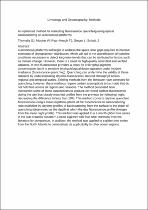 ResearchSpace
ResearchSpace
An optimized method for correcting fluorescence quenching using optical backscattering on autonomous platforms
JavaScript is disabled for your browser. Some features of this site may not work without it.
- ResearchSpace
- →
- Research Publications/Outputs
- →
- Journal Articles
- →
- View Item
| dc.contributor.author |
Thomalla, Sandy J

|
|
| dc.contributor.author |
Moutier, William

|
|
| dc.contributor.author |
Ryan-Keogh, Thomas J

|
|
| dc.contributor.author |
Gregor, Luke

|
|
| dc.contributor.author |
Schutt, Julia

|
|
| dc.date.accessioned | 2019-04-10T10:50:04Z | |
| dc.date.available | 2019-04-10T10:50:04Z | |
| dc.date.issued | 2017-12 | |
| dc.identifier.citation | Thomalla, S.J., Moutier, W., Ryan-Keogh, T.J., Gregor, L and Schutt, J. 2017. An optimized method for correcting fluorescence quenching using optical backscattering on autonomous platforms. Limnology and Oceanography: Methods, DOI: 10.1002/lom3.10234 | en_US |
| dc.identifier.issn | 1541-5856 | |
| dc.identifier.uri | http://onlinelibrary.wiley.com/doi/10.1002/lom3.10234/abstract | |
| dc.identifier.uri | http://hdl.handle.net/10204/10932 | |
| dc.description | Copyright: 2017 Wiley. Due to copyright restrictions, the attached PDF file only contains the abstract of the full text item. For access to the full text item, kindly consult the publisher's website. | en_US |
| dc.description.abstract | Autonomous platforms will begin to address the space-time gaps required to improve estimates of phytoplankton distribution, which will aid in the quantification of baseline conditions necessary to detect long-term trends that can be attributed to factors such as climate change. However, there is a need for high quality controlled and verified datasets. In vivo fluorescence provides a proxy for chlorophyll pigment concentration, but it is sensitive to physiological downregulation under incident irradiance (fluorescence quenching). Quenching can undermine the validity of these datasets by underestimating daytime fluorescence derived chlorophyll across regional and temporal scales. Existing methods from the literature have corrected for quenching, however, these methods require certain assumptions to be made that do not hold true across all regions and seasons. The method presented here overcomes some of these assumptions to produce corrected surface fluorescence during the day that closely matched profiles from the previous (or following) night, decreasing the difference to less than 10%. This method corrects daytime quenched fluorescence using a mean nighttime profile of the fluorescence to backscattering ratio multiplied by daytime profiles of backscattering from the surface to the depth of quenching (determined as the depth at which the day fluorescence profile diverges from the mean night profile). This method was applied to a 7-month glider time series in the sub-Antarctic Southern Ocean together with four other methods from the literature for comparison. In addition, the method was applied to a glider time series from the North Atlantic to demonstrate its applicability to other ocean regions. | en_US |
| dc.language.iso | en | en_US |
| dc.publisher | Wiley | en_US |
| dc.relation.ispartofseries | Worklist;20295 | |
| dc.subject | Sub-Antarctic Southern Ocean | en_US |
| dc.subject | Fluorescence quenching | en_US |
| dc.subject | Autonomous platforms | en_US |
| dc.subject | Backscattering | en_US |
| dc.title | An optimized method for correcting fluorescence quenching using optical backscattering on autonomous platforms | en_US |
| dc.type | Article | en_US |
| dc.identifier.apacitation | Thomalla, S. J., Moutier, W., Ryan-Keogh, T. J., Gregor, L., & Schutt, J. (2017). An optimized method for correcting fluorescence quenching using optical backscattering on autonomous platforms. http://hdl.handle.net/10204/10932 | en_ZA |
| dc.identifier.chicagocitation | Thomalla, Sandy J, William Moutier, Thomas J Ryan-Keogh, Luke Gregor, and Julia Schutt "An optimized method for correcting fluorescence quenching using optical backscattering on autonomous platforms." (2017) http://hdl.handle.net/10204/10932 | en_ZA |
| dc.identifier.vancouvercitation | Thomalla SJ, Moutier W, Ryan-Keogh TJ, Gregor L, Schutt J. An optimized method for correcting fluorescence quenching using optical backscattering on autonomous platforms. 2017; http://hdl.handle.net/10204/10932. | en_ZA |
| dc.identifier.ris | TY - Article AU - Thomalla, Sandy J AU - Moutier, William AU - Ryan-Keogh, Thomas J AU - Gregor, Luke AU - Schutt, Julia AB - Autonomous platforms will begin to address the space-time gaps required to improve estimates of phytoplankton distribution, which will aid in the quantification of baseline conditions necessary to detect long-term trends that can be attributed to factors such as climate change. However, there is a need for high quality controlled and verified datasets. In vivo fluorescence provides a proxy for chlorophyll pigment concentration, but it is sensitive to physiological downregulation under incident irradiance (fluorescence quenching). Quenching can undermine the validity of these datasets by underestimating daytime fluorescence derived chlorophyll across regional and temporal scales. Existing methods from the literature have corrected for quenching, however, these methods require certain assumptions to be made that do not hold true across all regions and seasons. The method presented here overcomes some of these assumptions to produce corrected surface fluorescence during the day that closely matched profiles from the previous (or following) night, decreasing the difference to less than 10%. This method corrects daytime quenched fluorescence using a mean nighttime profile of the fluorescence to backscattering ratio multiplied by daytime profiles of backscattering from the surface to the depth of quenching (determined as the depth at which the day fluorescence profile diverges from the mean night profile). This method was applied to a 7-month glider time series in the sub-Antarctic Southern Ocean together with four other methods from the literature for comparison. In addition, the method was applied to a glider time series from the North Atlantic to demonstrate its applicability to other ocean regions. DA - 2017-12 DB - ResearchSpace DP - CSIR KW - Sub-Antarctic Southern Ocean KW - Fluorescence quenching KW - Autonomous platforms KW - Backscattering LK - https://researchspace.csir.co.za PY - 2017 SM - 1541-5856 T1 - An optimized method for correcting fluorescence quenching using optical backscattering on autonomous platforms TI - An optimized method for correcting fluorescence quenching using optical backscattering on autonomous platforms UR - http://hdl.handle.net/10204/10932 ER - | en_ZA |





